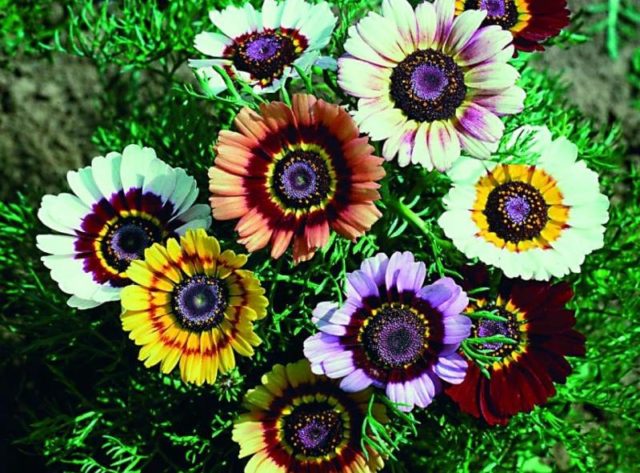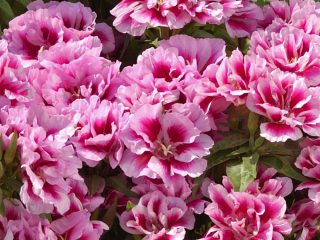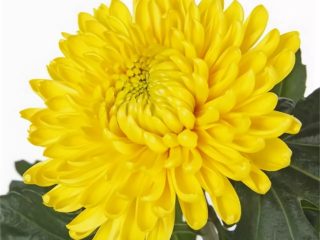Content
- 1 Are there annual chrysanthemums?
- 2 How to distinguish perennial chrysanthemums from annual ones
- 3 Varieties of annual chrysanthemums
- 4 Planting and caring for annual chrysanthemums
- 5 Propagation of annual chrysanthemums
- 6 Diseases and pests of annual chrysanthemums
- 7 Photos of annual chrysanthemums
- 8 Conclusion
The annual chrysanthemum is an unpretentious crop of European or African origin. Despite the relative simplicity of the flower structure, it has a spectacular appearance due to its bright colors and variety of colors. Grows well in temperate climates and has a long flowering time.
Are there annual chrysanthemums?
The classic perennial chrysanthemum is native to northeast China. Most of these plants, despite their spectacular appearance, are very demanding to care for and have complex agricultural technology. Annual chrysanthemums are mainly representatives of certain types of decorative crops of Mediterranean or North African origin.
In fact, there are three main types of these plants: keeled or tricolor chrysanthemums, field (sown) chrysanthemums, and crown chrysanthemums.
The first of the listed species contains the most beautiful and spectacular plants.As a rule, it was used to breed most varieties of chrysanthemums. The height of these varieties ranges from 15 to 60 cm.
Field chrysanthemums are actually weeds that act as competitors for cereal crops (especially wheat and corn). Mostly these are plants of the lower tier.
The coronal species are also quite decorative, but not as diverse as the tricolor ones. They are the tallest, reaching up to 100 cm.
How to distinguish perennial chrysanthemums from annual ones
These groups of plants actually differ in species, that is, they are different biological species. But gardeners are of little interest in the chromosomal set of crops; for them, differences in appearance and cultivation characteristics are important.
Most perennial chrysanthemums have complex, lush inflorescences, while annuals are predominantly similar to daisies or asters. The flowering time of annual crops is longer, and the buds themselves bloom earlier.
The shape of the root system also differs: representatives of the Chinese species have a strong tap root, while the inhabitants of the Mediterranean have a near-surface distributed system of roots.
Varieties of annual chrysanthemums
In terms of varietal diversity, annual chrysanthemums can only be compared with asters. The choice of existing varieties is quite wide, and even the most sophisticated connoisseurs of variegated shades will find something they like among this culture.
German flag
The variety German Flag (Chrysanthemum German Flag) is a plant up to 50 cm high with a daisy-shaped flower. The diameter of the inflorescence is 7-8 cm.Its middle is dark, and the leaves have a gradient yellow-red color, resembling the flag of the Federal Republic of Germany.

One bush can have up to two to three dozen inflorescences of different ages
The leaves of the variety are sessile, oblong, often having serrated edges. Likes to grow in light soils with added lime.
Dunetti
The large-flowered variety of the keeled chrysanthemum Dunetti (Chrysanthemum Carinatum Dunetti) has a height of 80 to 100 cm. The flowers are double, reaching a diameter of up to 15 cm. Even within the same variety, the colors of Dunetti can be very diverse. This variety is sold on the market under the name “terry mixture”.

It is believed that the color of the Dunetti variety depends on the acidity of the soil in which it is grown, as well as on the time of flowering
The leaves of the plant have a dark green tint and are pubescent. Based on the appearance and structural features of the bush (thick stem, taproot, etc.), Dunetti is very easy to confuse with perennial chrysanthemums, but this, unfortunately, is not the case.
Rainbow
Rainbow (Chrysanthemum Rainbow) is one of the most variegated varieties, with the largest number of shades. Their diversity creates a rainbow effect, which is reflected in the name of the variety. According to the characteristics, it is an ordinary keeled chrysanthemum, the height of the stem is no more than 60 cm, the diameter of the flower is 5-7 cm. The leaves are thin, almost needle-shaped, of a light green hue.

The variety has an incomparable color - one bush can even have multi-colored flowers
Rainbow blooms relatively later, starting in mid-June. However, its duration is consistent with other annual chrysanthemums, lasting until October.
Helios
Helios (Chrysanthemum Helios) is an annual crop, not inferior in decorative value to most perennials. It makes a very impressive impression thanks to the unusual shape of the petals. It is a typical representative of crown chrysanthemums. Reaches a height of 80-90 cm, the diameter of the flowering part is up to 12 cm. All Helios petals are curved inside the flower.

A special feature of the variety is the gradual opening of the petals and their color change during the flowering period, which lasts more than two weeks.
Most often, the color of this variety is red-golden, but both yellow and orange specimens are found. The end of Helios flowering occurs at the first frost.
Planting and caring for annual chrysanthemums
Annual chrysanthemums are very easy to grow. With minimal care and attention from the grower, very good results can be obtained. Annual chrysanthemums can be grown almost throughout the entire temperate climate.
Selection and preparation of a landing site
It is recommended to plant annual chrysanthemums in sunny areas protected from the north wind. Soil preparation begins in the fall of last year. To do this, fertilizers should be added to it - up to 50 g of superphosphate and 20 g of potassium sulfate per square meter. m.
The area is carefully dug up and watered. In the spring, after the snow melts, it is advisable to apply rotted manure to it. Then dig up the area a second time.
Landing rules
The easiest way to grow is to directly plant seeds in the ground. You can also use seedlings. Whether this is necessary or not, each grower decides for himself.In the southern regions, this will give an advantage of a maximum of two weeks (very rarely three). In the northern regions, thanks to this method of cultivation, you can accurately determine the timing of planting in order to achieve flowering literally 10-15 days after it.
In any case, the algorithm for planting and growing young plants is approximately the same. Furrows up to 5 mm deep are made on the site, into which seeds are planted in increments of 20 cm. When planting seedlings, they are placed in a square manner, 5 by 5 cm.
Next, the grooves are covered with earth, watered and covered with plastic film. Remove the film (both in the garden and at home) as soon as the first shoots appear. This usually happens within 1-2 weeks.
After 10 days, annual chrysanthemums should be fed with Ideal or Flower fertilizer. As soon as the height of the plants reaches 10-12 cm, they are thinned out (if planted in the garden). If seedling cultivation was used, then the bushes can already be planted in open ground.
Watering and fertilizing
Watering is carried out as needed. As soon as the top layer of soil is covered with a crust, it is loosened, and at the end of the procedure, watered with warm, settled water. Watering should be done exclusively in the evening. Sprinkling is allowed, but should not be overused, especially in humid climates.
Fertilizing is carried out regularly from the moment flowering begins. The frequency of fertilization is once every 3-4 weeks. Use a complex universal fertilizer for ornamental plants.
Propagation of annual chrysanthemums
Unlike perennial chrysanthemums, which are propagated primarily vegetatively, annual chrysanthemums are propagated using the seed method. This is a fairly simple process that anyone can do.
As soon as flowering on a particular peduncle ends, a small seed pod is formed there. It ripens within 1-1.5 months, after which it is cut and sent to dry.
To do this, the seeds are placed on a wooden surface or in a small chintz bag and hung in a ventilated room without access to light. Drying time is about 2-3 weeks. After which the seeds can be stored for 2 years with virtually no loss of germination. In the third year it drops to 50-60%.
Diseases and pests of annual chrysanthemums
Being ornamental plants with a very multifaceted history of selection, annual chrysanthemums can be susceptible to a large number of diseases. Manifestations of fungal infections are practically the norm for such flowers.
The most common disease is gray mold. The symptoms of the disease are standard - the appearance of small local formations of brown color, reminiscent of mold.

Gray mold damage begins with young leaves located closer to the top
There is no treatment. If even a small part of the plant is damaged, it should be removed from the soil and burned. In addition, it is recommended to disinfect the place where the bush grew. It can be made with any copper-containing preparation.
Preventive measures include timely disinfection of planting material, as well as garden tools.
Aphids pose a particular danger to the plant. Typically, annual chrysanthemums are affected by either the white greenhouse aphid or the brown chrysanthemum aphid. From the point of view of the negative impact of possible consequences and methods of control, these two insects are completely identical. All differences are only in appearance.

White greenhouse aphids like to hide under the surface of leaves.
To get rid of aphids on annual chrysanthemums, it is enough to treat the bushes with a solution of copper sulfate and soap in water (200 g, 20 g and 10 l, respectively). This can be done using a sprayer. If necessary, repeat after 1-2 weeks.
Photos of annual chrysanthemums
The photo below shows various ways to use annual chrysanthemums in garden design:

Mostly annual chrysanthemums are used as a filler for mixborders

Low-growing varieties (for example, Kamina Red) when planted densely act as cover plants

Annual chrysanthemums are often grown in pots and flowerpots

In flower beds, these plants predominantly fill areas of medium and low level

Annual cut chrysanthemums can be obtained in pots at almost any time of the year.
Conclusion
The annual chrysanthemum is a beautiful and long-flowering plant, which is the closest relative of asters. Unlike perennial varieties, this crop is unpretentious in care, relatively resistant to disease and can withstand long periods of cold weather. In landscape design, annual chrysanthemums are mainly used as plants of the lower and middle tier.








